Chickens are interesting animals with a fascinating history. They have been critical to human societies for thousands of years and continue to wield great significance today. There are many common, familiar types of chickens, but these docile egg-laying breeds are not representative of all chickens. This article will discuss 6 of the most aggressive chicken breeds and provide insight as to why they behave this way.
Background
Chicken Breeding
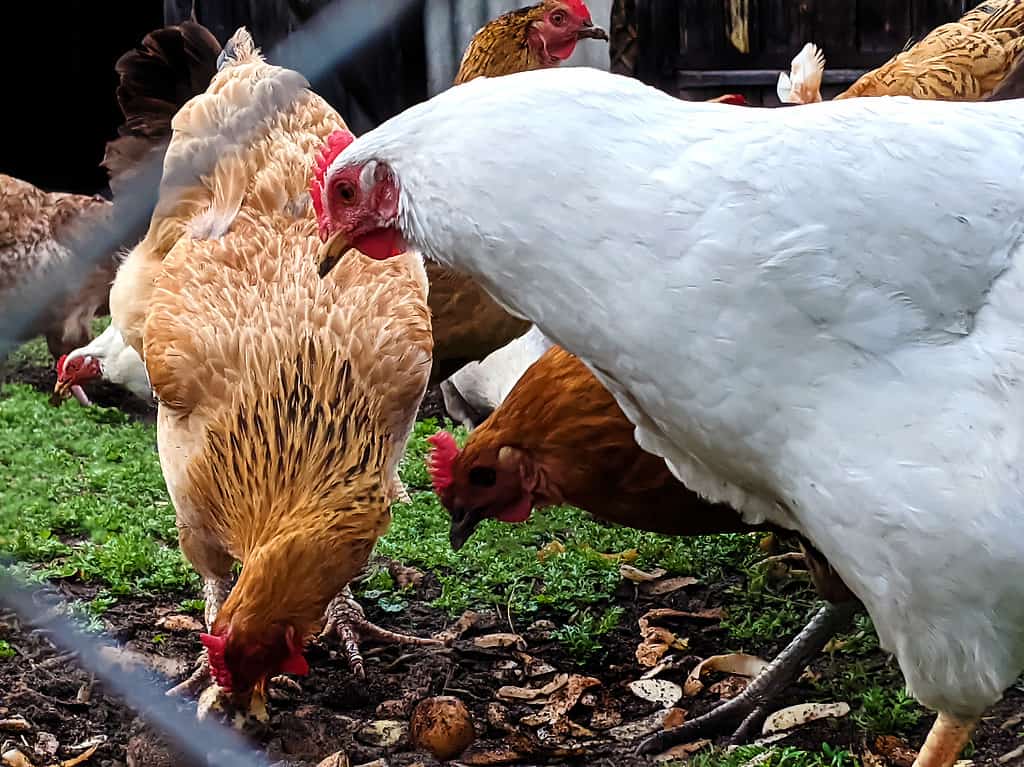
Domesticated chickens have many purposes including producing meat and eggs.
©Dmitriy Prokofev/iStock via Getty Images
Chickens were first domesticated in Southeast Asia, likely around 8,000 to 10,000 years ago. The red junglefowl (Gallus gallus), native to the region encompassing modern-day Thailand, Vietnam, and Indonesia, is the wild ancestor of the domestic chicken. Early domestication was driven by their dual utility as sources of both meat and eggs. As human societies expanded, chickens spread to various parts of the world, including Europe, Africa, and the Americas, through trade routes and exploration.
Throughout history, different cultures selectively bred chickens to suit their needs. In ancient Egypt, chickens were prized for their religious symbolism and eventually became more common as a food source. In ancient Rome, they were raised for both culinary purposes and cockfighting, a popular form of entertainment. Later, during the Middle Ages, European monks played a role in preserving and selectively breeding different chicken breeds. By the 19th century, poultry shows and exhibitions gained popularity, leading to the development of numerous distinct breeds for ornamental and practical purposes.
The advent of modern industrial agriculture in the 20th century brought about specialized breeding programs focused on optimizing meat and egg production. This led to the creation of broiler chickens and layers, respectively. Genetic selection accelerated the growth rates and production capabilities of chickens, significantly altering their biology. Meanwhile, conservation efforts also emerged to protect heritage and rare breeds from extinction, preserving genetic diversity and historical significance.
Cockfighting
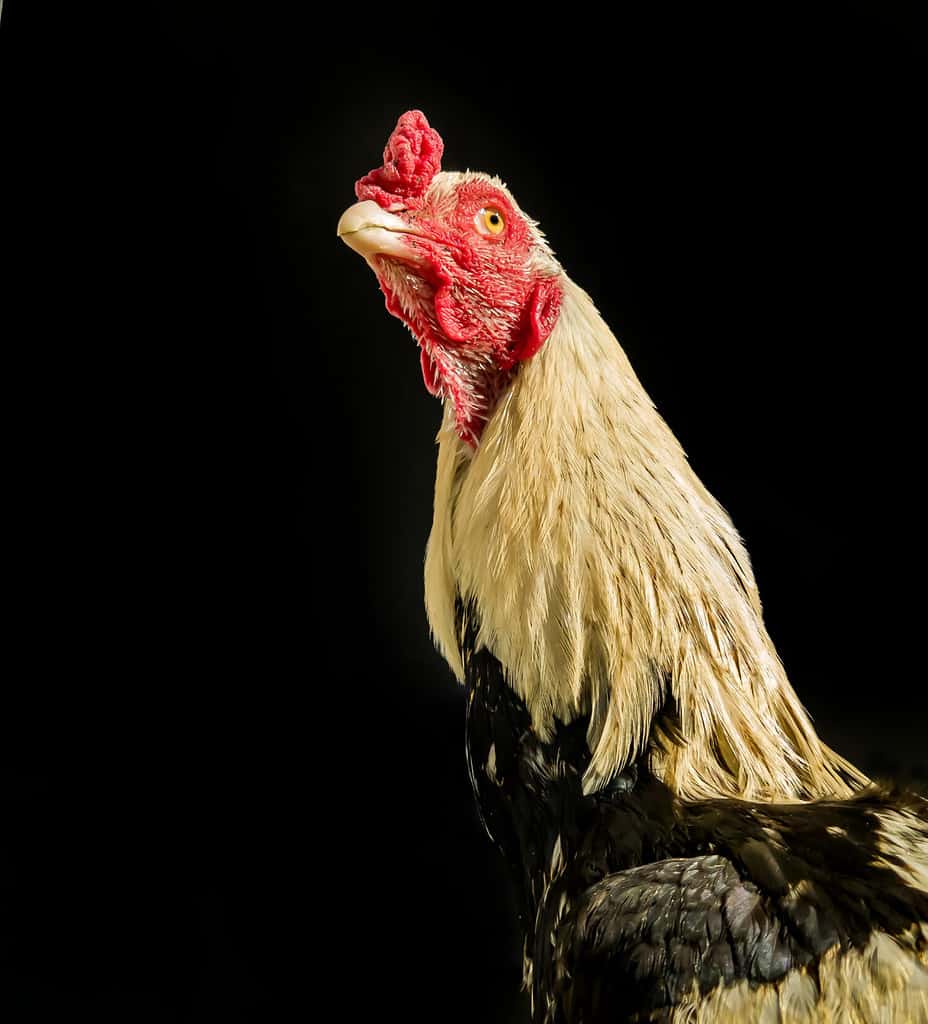
Breeding cockfighting chickens usually targets traits like aggression and strength.
©Zeeshan Naveed/Shutterstock.com
Cockfighting, a practice where two specially bred roosters engage in combat for entertainment or betting, has a long and diverse history. Its origins trace back to ancient times, with evidence suggesting it began in Southeast Asia, particularly in regions that now include Thailand and Indonesia. From there, cockfighting spread across various cultures, becoming popular in ancient Greece and Rome, where it often had cultural and religious significance.
Cockfighting gained widespread popularity in medieval Europe, the Middle East, and Asia, with distinct variations in rules and rituals. During colonial times, it was introduced to the Americas, where it flourished in places like the Caribbean and parts of South America. Over centuries, the practice evolved, influencing the development of specific breeds bred for fighting prowess.
As societal attitudes shifted and concerns about animal cruelty emerged, however, many countries and regions banned or heavily regulated cockfighting. Today, the practice is illegal in most Western countries and parts of Asia. Despite this, cockfighting continues in some places where it retains cultural significance or remains unregulated. Countries like the Philippines, Mexico, parts of Central and South America, and parts of Southeast Asia still have active cockfighting scenes, though it’s a controversial activity with ongoing debates about its ethics and legality.
#1 Malay Chickens
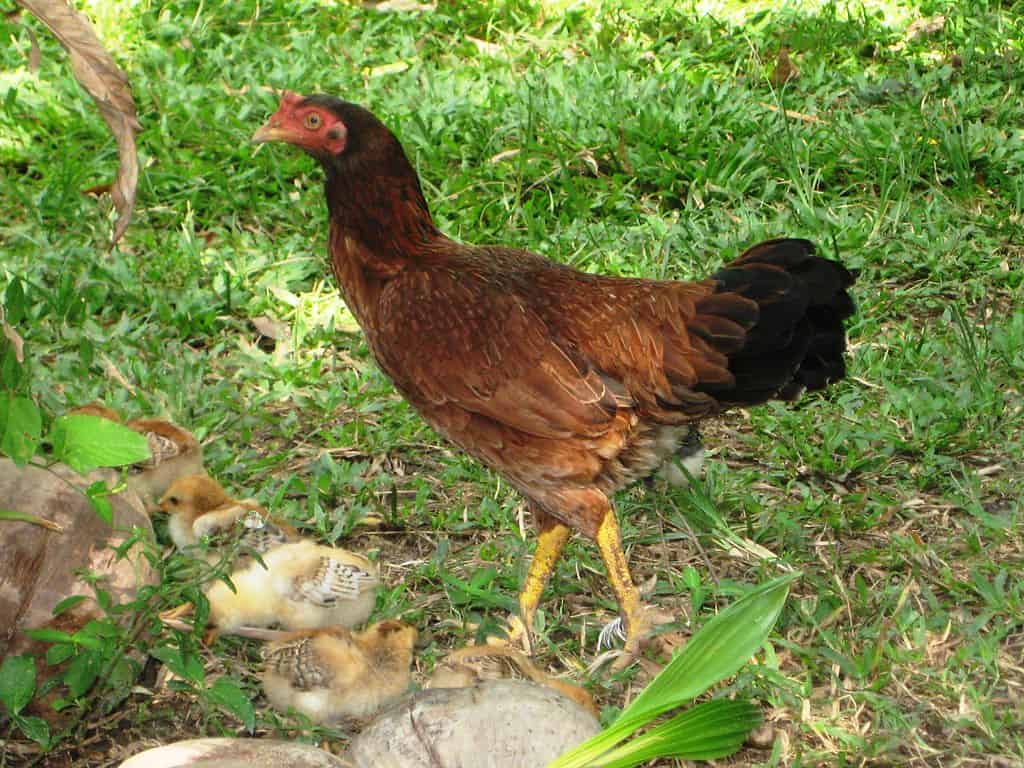
Malay chickens are tall birds that can achieve significant weights in males.
©Zamwan, CC BY-SA 3.0 <https://creativecommons.org/licenses/by-sa/3.0>, via Wikimedia Commons – License
Malay chickens are famous for their highly aggressive temperament. They tend to be combative with other chickens, often engaging in fierce battles for dominance. While not typically aggressive toward humans, their territorial behavior can occasionally lead to caution around unfamiliar individuals. Malays might also challenge other animals in their environment. Their aggressive nature results from a long history of breeding for cockfighting.
Malay chickens are imposing birds with a distinct appearance. They are remarkably tall, often reaching over 2 feet in height, and have powerful legs and a streamlined body. Roosters can weigh around 9-13 pounds, while hens are smaller. Their feather colorations range from solid black to red and black combinations. Malays are known for their single, upright comb and strikingly long neck and legs.
#2 Old English Game Chickens
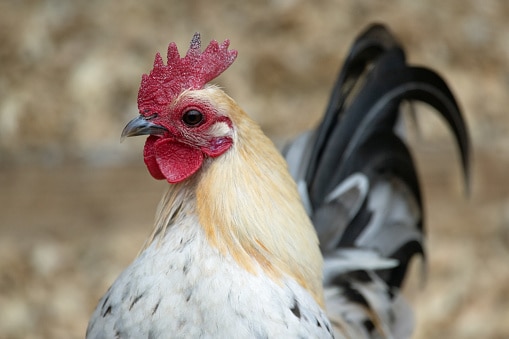
Old English Game chickens have particularly eye-catching colorations. Although these animals are beautiful, however, they can also be dangerous.
©JZHunt/iStock via Getty Images
Old English Game chickens are known for their intense aggression, especially among males. Like the Malay chicken, Old English Game chickens were originally bred for cockfighting. Consequently, they engage in fierce battles for dominance and might attack other chickens, often leading to injuries. While not prone to attacking humans, caution is advisable due to their territorial disposition. Their aggressive tendencies extend to other animals as well, making them unsuitable for coexisting with other species. They are not excessively noisy, focusing more on assertive behaviors than constant vocalizations.
Old English Game chickens are relatively small, agile birds with a striking appearance. Roosters usually weigh around 4-5 pounds, while hens are slightly lighter. They come in a variety of feather colors, including black, red, white, and more, often with intricate patterns. Known for their upright posture and keen demeanor, they have a distinctive appearance with a well-defined, sleek body, long neck, and small head.
#3 Cornish Chickens
The Cornish chicken is the next aggressive chicken breed. It is originally from Cornwall, England and is a relatively large breed originally popular for cockfighting. They are extremely aggressive and have a reputation of attacking and sometimes killing other animals and chickens. Cornish chickens are also very noisy and can be a nuisance to owners and neighbors alike.
This breed, sometimes called the Indian game chicken, is a hefty bird with interesting colorations. The Cornish chicken has feathers with a mix of colors including iridescent greens, brown, and blue. There are also white Cornish chickens, but these are less common. These meaty birds can weigh around 9 pounds and are quite muscular.
#4 Cubalaya Chickens
Cubalaya chickens can exhibit an assertive and combative demeanor, especially towards other chickens of the same sex. They might engage in aggressive behaviors such as pecking and sparring to establish dominance within their flock. While they generally have tame behavior and are not a threat to humans, they were bred for cockfighting and retain the related traits. Additionally, Cubalayas can be noisy.
Cubalaya chickens are medium-size birds weighing around 4-5 pounds for hens and 5-6 pounds for roosters. They boast striking and vibrant feather colorations, featuring a mix of iridescent black, white, and red markings. Distinguishing traits include their upright stance, prominent horizontal back line, and distinctive high-set single comb. They have a compact yet elegant body with long, powerful legs and a strong, curved beak, giving them a regal and captivating appearance.
#5 Brahma Chickens
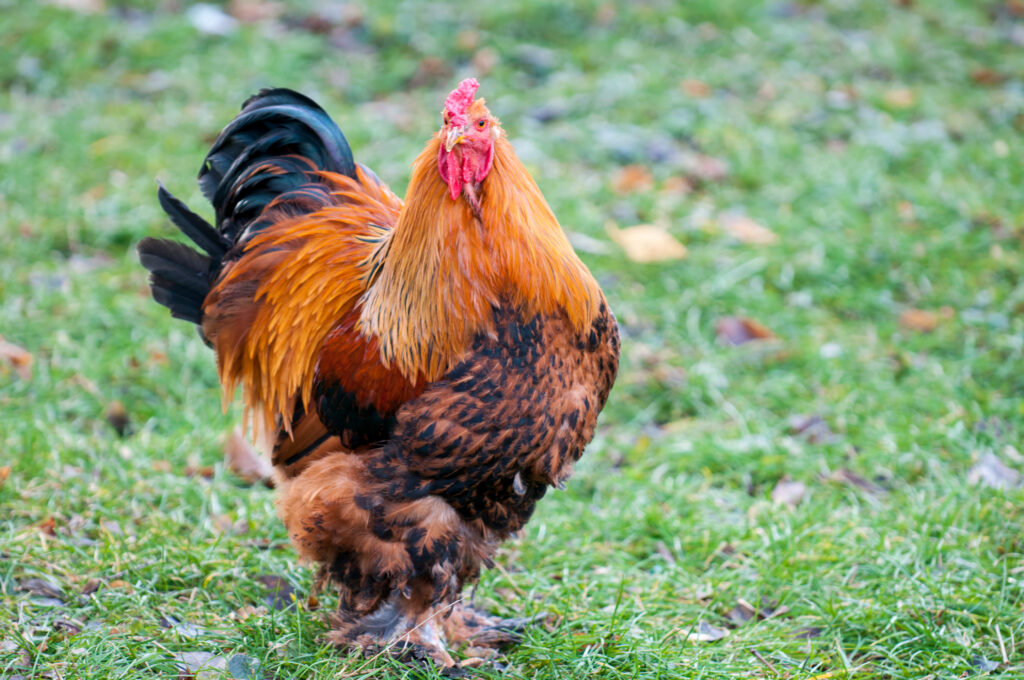
Brahma chickens are one of the largest chickens in the world.
©Yuriy Bartenev/Shutterstock.com
Brahma chickens are the next breed of possible monster chickens. This breed was developed in the United States and has a large body size. Brahma chickens can be aggressive, noisy, and strong. When they attack, they often are capable of inflicting significant injuries to humans and other animals. They can kill other chickens if provoked, as well. Although they have aggressive tendencies, they were bred for their meat, not for cockfighting. They can live safely in a flock, but beware of their potential for aggression.
Brahma chickens are large, majestic birds known for their impressive size and distinctive appearance. These chickens can weigh up to 10 to 12 pounds! They have a compact, upright stance with feathers covering their legs and feet. This creates a feathered “boots” effect. Their round bodies have dense, loose plumage that comes in various color patterns, including light and dark shades. Brahma chickens boast a unique pea comb and strikingly large, expressive eyes.
#6 Dorking Chickens
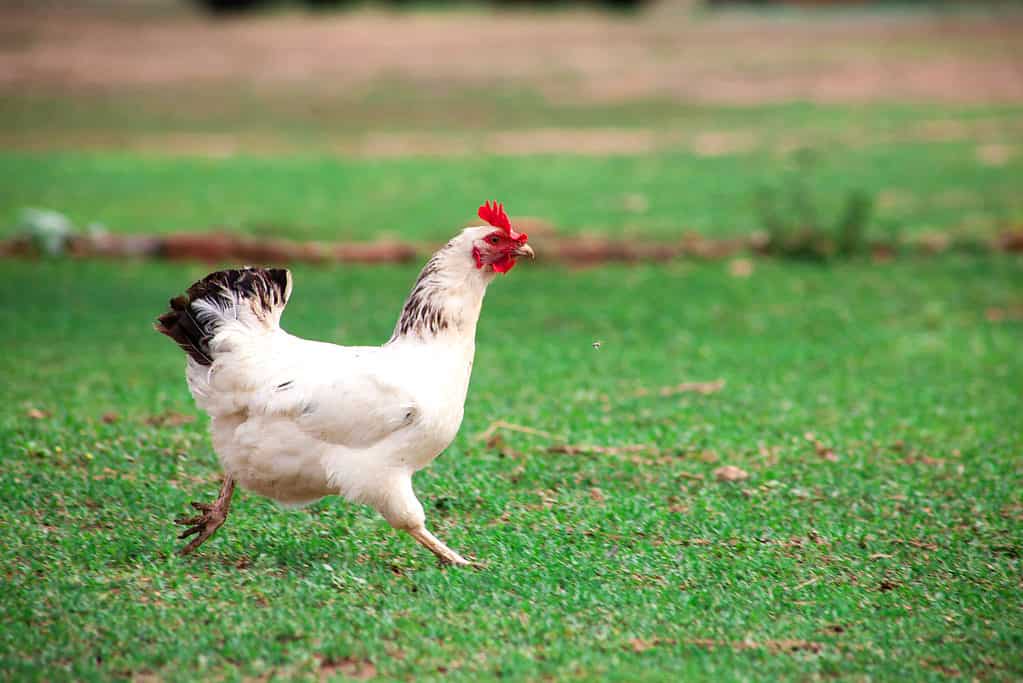
Dorking chickens are extremely rare and are notable for their frantic behavior.
©iStock.com/Mironmax Studio
The final chicken we will investigate is the Dorking chicken, from Dorking, England. These chickens famously have very frantic and chaotic behavior that can lead to self-inflicted injuries. They do not attack humans, other animals, and other chickens as frequently than other breeds and are not conventionally aggressive, but their behavior can cause injury to themselves or other chickens. Like the Cornish chicken, Dorking chickens were bred for their meat and eggs, not for cockfighting.
Dorking chickens are one of the oldest breeds of chicken, potentially dating back as far as 43 AD. The breed was notable throughout history because they provide especially tasty meat. They are stout, with a large, bright red comb, short legs, and a fifth toe. Aside from their black tail feathers, Dorking chickens are typically white or silver-grey in color.
The photo featured at the top of this post is © Horse Crazy/Shutterstock.com
Thank you for reading! Have some feedback for us? Contact the AZ Animals editorial team.






